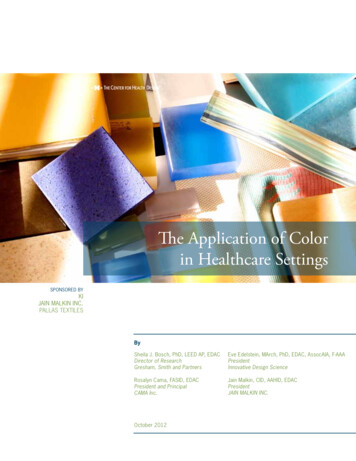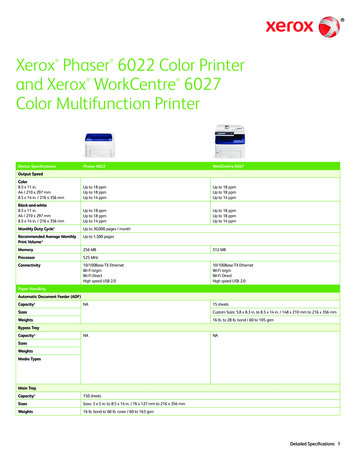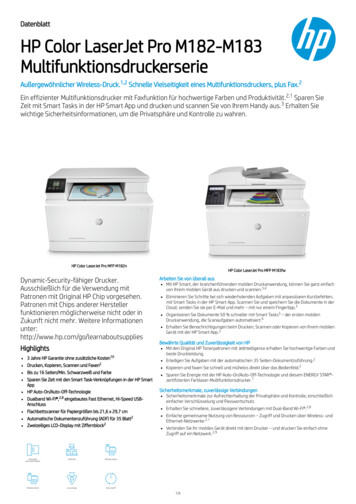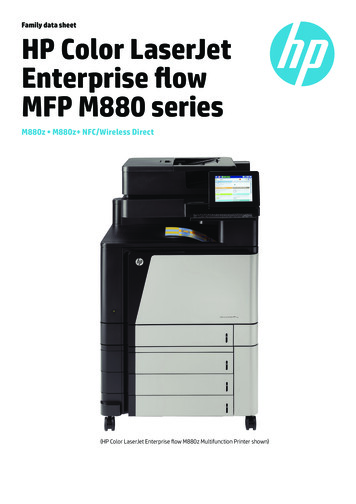
Transcription
The Application of Colorin Healthcare SettingsSPONSORED BYKIJAIN MALKIN INC.PALLAS TEXTILESBySheila J. Bosch, PhD, LEED AP, EDACDirector of ResearchGresham, Smith and PartnersEve Edelstein, MArch, PhD, EDAC, AssocAIA, F-AAAPresidentInnovative Design ScienceRosalyn Cama, FASID, EDACPresident and PrincipalCAMA Inc.Jain Malkin, CID, AAHID, EDACPresidentJAIN MALKIN INC.October 2012
About the AuthorsSheila J. Bosch, PhD, LEED AP, EDAC - sheila bosch@gspnet.comSheila J. Bosch serves as the director of research and innovation for Gresham, Smithand Partners. An invited member of The Center for Health Design’s ResearchCoalition and an active participant in national-level research activities, Bosch is arecognized expert in her field. Her more than 20 years of professional experiencehave led to numerous opportunities to publish articles on a variety of issues andspeak to healthcare industry professionals on topics such as the role of researchersin healthcare architectural practice, improving healthcare through building design,process improvement initiatives in the emergency department, and evidence-baseddesign for women and infants facilities. Whether conducting research or providingconsulting services, Bosch is committed to improving the built environment, thenatural environment, and the well-being of building occupants.Rosalyn Cama, FASID, EDAC - rcama@camainc.comRosalyn Cama is the president and principal interior designer of the evidence-basedplanning and design firm CAMA, Inc., in New Haven, CT. She has served as the24th president of the American Society of Interior Designers (ASID) and currentlyserves as chair of the board for The Center for Health Design. Cama has authoredEvidence-Based Healthcare Design, a John Wiley & Sons publication, and frequentlywrites and lectures on the topic. Recognized as an industry leader, Healthcare Designmagazine named Cama as one of the 25 “Most Influential People” in healthcaredesign in 2009-10, and ASID named her Designer of Distinction in 2012. Cama iscurrently engaged in the development of the Global Institute of Biophilic Design.www.camainc.com2 About
Eve Edelstein, MArch, PhD, EDAC, AssocAIA, F-AAA - neuroarchitecture@gmail.comEve Edelstein is founder and president of Innovative Design Science, a researchbased design consultancy that integrates information from the biomedical sciencesand 4D immersive virtual mockups to inform design projects. As a researchspecialist at Calit2, University California, San Diego, her work in neuro-architecturehas developed wearable wireless human biosensors and real-time 3D modelingsoftware to test design in immersive virtual reality mockups and real-world projects.Edelstein’s contributions include research-based design guidelines for the CanadianMinistry of Health (1 million square foot mental and general health facility); inChina (2.4 million square foot hospital campus); and for emergency, operatingsuites, ICUs, PACUs, and educational facilities in the United States.Edelstein is a research fellow with the Academy of Neuroscience for Architectureand teaches courses and workshops in research-based design, immersive 4D virtualmodeling, and developed the first series of courses in neuro-architecture. Edelstein’swork can be viewed in the BBC TV The Secret life of Buildings and the PBS specialthe Science of Healing and at www.InnovativeDesignScience.com.Jain Malkin, CID, AAHID, EDAC - jmalkin@jainmalkin.comJain Malkin is president of Jain Malkin Inc., a San Diego, CA, interior architecturefirm specializing in evidence-based design. She is the author of several well-knownbooks on healthcare design, most recently, A Visual Reference for Evidence-BasedDesign, published by The Center for Health Design, and she lectures globally onthese topics. Malkin was named one of the “Most Influential People” in healthcaredesign by Healthcare Design magazine, and she was awarded the 1997 Hyde chairof excellence at the University of Nebraska College of Architecture. She is a boardmember of The Center for Health Design and on the editorial advisory board of theHealth Environments Research & Design (HERD) Journal.About 3
About the FundersJain Malkin Inc.Jain Malkin Inc. is an interior architecture firm recognized internationallyin the field of healthcare design and senior living. The firm has been anadvocate for research-based design since Jain Malkin’s book Hospital InteriorArchitecture was published in 1992. That book had a chapter on the use ofcolor in healthcare facilities to help guide practitioners in this importantcomponent of interior design. “The Application of Color in HealthcareSettings” continues this valuable discussion. www.jainmalkin.com.KIKI manufactures innovative furniture and moveable wall system solutionsfor education, healthcare, government, and corporate markets. Theemployee-owned company is headquartered in Green Bay, WI, andoperates sales offices and manufacturing facilities in the United States,Canada, Latin America, Europe, and Asia. KI tailors products and servicesolutions to the specific needs of each customer through its unique designand manufacturing philosophy. For more information, visit www.ki.com.Pallas TextilesFor more than 20 years, Pallas Textiles has collaborated with some ofthe best-known textile designers to create an impressive portfolio ofaward-winning collections. Named for Pallas Athena, Greek Goddess ofWeaving, Pallas Textiles offers sophisticated, elegant products that aresmart, balancing high-performance characteristics and environmentalresponsibilities. Collections include textiles for contract upholstery andpanel systems, wall-coverings, textiles for healthcare environments andcasements. Pallas Collections are designed to harmonize with the totalinterior environment and its furnishings. For more information, visitwww.pallastextiles.com.4 About
AcknowledgmentsThe authors are grateful to KI and JAIN MALKIN INC. for their generous support tomake the publishing of this paper possible. Special thanks to Debra Levin and CatherineAncheta from The Center for Health Design for their direction and guidance over thecourse of this project.The authors would like to acknowledge Jin Gyu “Phillip” Park, PhD, assistant professor atNorth Texas University, for his contribution to the Appendix. Also, thank you to HannahHobbs and Katherine Hamby, students of NewSchool of Architecture and Design, SanDiego, for their research assistance in sifting through all the relevant literature.The authors are appreciative of Lisa Richter of Richter Communications for her work inputting together the different writing styles into a cohesive paper and to Elizabeth Oshanaof CAMA Inc. for adding the final design touch.Published by The Center for Health Designwww.healthdesign.orgCopyright 2012 by The Center for Health Design. All rights reserved. No part of thiswork covered by the copyright may be reproduced by any means or used in any formwithout written permission of the publishers except to make a single project copy and asingle archival copy for the sole use of the individual or organization reading this report.The Center for Health DesignThe Center for Health Design (CHD) is a nonprofit organization thatengages and supports professionals and organizations in the healthcare,construction, and design industry to improve the quality of healthcarefacilities and create new environments for healthy aging. CHD’smission is to transform healthcare environments for a healthier, saferworld through design research, education, and advocacy.Acknowledgments 5
Material PaletteThis colorful materialpalette brightens achildren’s hospital.EL PASO CHILDREN’S HOSPITALINTERIOR DESIGN: CAMA Inc.ARCHITECT: KMD ArchitectsPHOTOGRAPHER: CAMA Inc.6 Table of Contents
The Application of Color in Healthcare SettingsTable of ContentsExecutive Summary . 08Introduction . 13Role of Color in Healthcare Environments . 15Current State of Research on Color . 15Color and Healing . 17Color Preference Associated With Aging . 17Children’s Preference in Healthcare Environments . 25Adolescent’s Preference in Healthcare Environments . 33Color in Psychiatric Settings . 35Color for Signage in Healthcare Settings . 43Discussion . 45Interpretation and Translation . 53Applications and Approaches . 55Design Considerations . 55Color and Its Effect on the Perception of Space . 58Sensitivity to Light and Color . 64Practical Applications of Color Psychology . 65Conclusion . 71References . 72Appendix . 74Cultural Implications of Color . 74Table of Contents 7
Executive SummaryIn the last half of this century, a vast number of books have been written on the topicof color—the psychology of color, color theory, color and the environment, colorand light, and color and culture to name a few. Interestingly, each is filled withindividual studies—not necessarily in healthcare—and many suggest definitive conclusions about the best colors for a range of users and settings, or color preferencesfor boys and girls, different cultures, and so forth.In today’s context of research, however, the methodological rigor of these studiesfalls short of what we have come to expect with the introduction of evidence-baseddesign. An extensive review of color literature carried out in 2004 by Tofle, Schwarz,Yoon, and Max-Royale concluded that there is insufficient evidence to assert that specific colors can evoke a certain mood, nor is there a link that can be made betweenspecific colors and health outcomes.Despite this, many studies describe how colors can influence performance and theexperience of a space. Color can create the illusion of a higher ceiling or a widerroom or facilitate cueing in wayfinding orientation. In the healthcare setting, thereare many functional uses of color. As an example, a color separation between thefloor and the wall in circulation spaces helps those with aging eyes to distinguishbetween different planes and reduce mobility issues. Since hospitals are likely to servean increasing number of aging baby-boomers in coming years, the many functionaluses of color related to aging and health are very relevant.Although rigorous rules for the application of color in healthcare settings will not befound in this paper, there are suggestions for the application of color as well as issuesfor practitioners to consider such as the type of activity that will occur in a space andwhether it requires concentration or social interaction, the age of the occupants, theirmobility, the nature and severity of the illness, and the amount of brightness andcontrast required to perform tasks safely.8 Executive Summary
The Application of Color in Healthcare SettingsMuch of what we think we know about color is anecdotal. The results of many colorstudies that are often quoted have been done in laboratory settings or using small color chips representing basic primary colors. This is very different than the experienceof color on walls in an interior environment. It is difficult to do controlled studies oncolor in real-world settings and even more challenging in clinical environments.This paper’s value is as a reference for architects and designers as it presents what iscurrently understood about color, separating research from experience and anecdote,and it is likely to give many design professionals confidence about the application ofcolor to their projects.The Appendix discusses the cultural implications of color.Executive Summary 9
Research HighlightsThis paper looks at studies of color in a number of differenthealthcare settings—from pediatric to geriatric nursing units—and considers a variety of uses—from signage to wayfinding.Here are some of the key findings from the literature review ofrigorous peer-reviewed studies on color in healthcare settingsduring the past decade.Dittmar (2001) found in a large-scale study using color namesalone (blue, green, red, yellow) highly significant differencesin color preference with advancing age; increased age wascorrelated with decreased preference for blue. There was nosignificant gender difference for preferred colors, but a genderdifference in least preferred colors.Park (2009) examined color preferences among pediatricoutpatients, inpatients, and healthy children and found nostatistically significant difference in color preference among thethree groups of children, and, therefore, did not support thehypothesis that pediatric patients would have different colorpreferences than healthy children. However, all preferencecomparisons revealed that white was the least preferred color.Gibson, MacLean, Borrie, and Geiger (2004) examined thebehavior of 19 residents in a long-term care dementia unit andfound that 13 used color to help them find their rooms, withstructure (e.g., room number, name plate) as the second mostoften reported visual cue.10 Executive Summary
The Application of Color in Healthcare SettingsBlumberg and Devlin (2006) used a demographicquestionnaire, a photographic comparison test, and a designquestionnaire with 100 junior high school students. Responsesto the photographic comparison test showing healthcaresettings indicated that adolescents prefer the “bright colors andinventive design” of a child-focused hallway. For a set of lobbyimages, the majority of the adolescents preferred the adultoriented photo, possibly because of the tricycle, pastel colors,and toys in the child-oriented lobby that were age-specific andnot geared toward adolescents.Color was one component of the changes made in a corridorof a psychiatric hospital intended to reduce the “institutional”feeling of the space and provide a “sense of nature” in apaper by Edgerton, Ritchie, and McKechnie (2010).The renovation did not affect the number of patients usingthe corridor, but there was an increase in the number ofpositive behaviors, although the difference was not statisticallysignificant, except for an increase in “talking” behavior.Rousek and Hallbeck (2011) report that color contrasts canimprove signage comprehension and conclude, from a limitedset of colors and graphics tested, that a combination of redand white backgrounds with black font was preferred. It shouldbe noted that the font, size, scale, and color contrast are veryimportant, along with the intelligibility of the design graphic itself.Executive Summary 11
Beyond VanillaWhite walls are often associated with a clinicalappearance and institutional settings. Adding color andan interesting ceiling design, as in this procedure room,can make the environment seem less intimidating.SCRIPPS CENTER FOR INTEGRATIVE MEDICINEINTERIOR DESIGN: Jain Malkin Inc.ARCHITECT: Schmidt Scanlon GordonPHOTOGRAPHER: Michael Campos12 Introduction
The Application of Color in Healthcare SettingsIntroductionThere are few design topics more interesting than the use of color in our daily lives.We are surrounded by an ever-changing palette of color in nature that inspires theprinciples used in the creation and selection of materials for interior design. Thesesame principles also apply in the culinary presentation of food and the creation offine art. Since color is an inseparable part of our lives, it is all the more puzzling toexplain the lack of it in many of our new hospitals.Thus, the origin of this paper is based on this very observation: A number of newhospitals built in the last five years have been lacking in color. We wondered whatforces are at work here? Clearly it is more difficult, and more risky, to successfullyapply color to an interior environment than to use a neutral palette, but there arelikely a number of factors in play here.The importance of this issue, however, goes beyond aesthetics. Is it possible toenhance the patient’s experience and potentially impact clinical outcomes byunderstanding how to apply color in healthcare settings? The environment may beeven more important in the acute-care setting. Recent neuroscientific research andstudies of circadian rhythms demonstrate that the color spectrum of light directlyinfluences human biological systems and health outcomes (Edelstein, 2008). Topicssuch as lighting, biophilic design, color theory and application, color and the agingeye, the cultural dimension of color, and physiological and psychological responsesto color all demand attention when thoughtfully designing and shaping the interiorenvironment.This paper will concentrate on the application of color in healthcare settings.Introduction 13
Color and BrandColor may be tied to an institution’slogo or corporate brand.YALE-NEW HAVEN HOSPITALINTERIOR DESIGN: CAMA Inc.ARCHITECT: Salvatore AssociatesPHOTOGRAPHER: Rick Scanlan14 Role of Color in Healthcare Environments
The Application of Color in Healthcare SettingsRole of Color inHealthcare EnvironmentsCurrent State of Research on ColorMany color guidelines have been proposed for healthcare settings, but these onlyoffer hypotheses suggesting that certain colors may be associated with the well-beingof the users of those spaces. Tofle, Schwarz, Yoon, and Max-Royale (2004) conductedan extensive literature review and analysis of several color guidelines and noted thatthere are considerable contradictions among guidelines and in the literature on color.Tofle et al. (2004) state that the art of specifying certain colors to evoke a particularmood or influence behavior is unsubstantiated by research evidence. Although somestudies have demonstrated that color-mood associations do exist, they could notconclude that there is a one-to-one relationship between a certain color and a specificemotion. We note for example, that while some designers use white to evoke a senseof clarity and denote cleanliness, others state that white walls are clinical and eveneerie.Edelstein and colleagues also conducted an extensive search of peer-reviewedliterature on the influence of light and color on behavior, emotion, function,cognition, circadian rhythms, and health (Edelstein, 2006; Edelstein, 2008;Edelstein, et al., 2008). They found the greatest consistency in color studies focusedon the brightness and color contrast, consistent with knowledge from the visualsciences and clinical research. Such research can be applied to manipulate perceptualimpressions, such as a sense of spaciousness. Together these literature reviewsconclude there was insufficient evidence to directly link specific colors with specificbehavioral or health outcomes.The authors conducted a broad search of color literature published, using searchterms focused on color in healthcare settings. The search i
in the field of healthcare design and senior living. The firm has been an advocate for research-based design since Jain Malkin’s book Hospital Interior Architecture was published in 1992. That book had a chapter on the use of color in healthcare facilities to help guide practitioners in this











